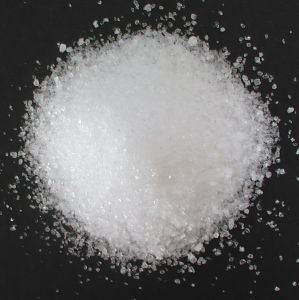Molar mass 136.086 g/mol Melting point 252.6 °C Boiling point 400 °C | Formula KH2PO4 Density 2.34 g/cm³ Soluble in Water | |
 | ||
Appearance White powderdeliquescent Related compounds IUPAC ID Potassium dihydrogen phosphate | ||
Monopotassium phosphate
Monopotassium phosphate, MKP, (also potassium dihydrogenphosphate, KDP, or monobasic potassium phosphate), KH2PO4, is a soluble salt of potassium and the dihydrogen phosphate ion which is used as a fertilizer, a food additive and a fungicide. It is a source of phosphorus and potassium. It is also a buffering agent. When used in fertilizer mixtures with urea and ammonium phosphates, it minimizes escape of ammonia by keeping the pH at a relatively low level.
Contents
- Monopotassium phosphate
- Th nghi m th qu t m dung d ch kh2po4 monopotassium phosphate
- Structure
- Manufacturing
- Applications
- References
Single crystals are paraelectric at room temperature. At temperatures below −150 °C (−238 °F) they become ferroelectric.
Th nghi m th qu t m dung d ch kh2po4 monopotassium phosphate
Structure
Monopotassium phosphate can exist in several polymorphs. At room temperature it forms paraelectric crystals with tetragonal symmetry. Upon cooling to −150 °C it transforms to a ferroelectric phase of orthorhombic symmetry, and the transition temperature shifts up to −50 °C to when hydrogen is replaced by deuterium. Heating to 190 °C changes its structure to monoclinic. When heated further, MKP decomposes, by loss of water, to potassium metaphosphate, KPO3, at 400 °C (752 °F).
Manufacturing
Monopotassium phosphate is produced by the action of phosphoric acid on potassium carbonate.
Applications
Fertilizer-grade MKP powder contains the equivalent of 52% P2O5 and 34% K2O, and is labeled NPK 0-52-34. MKP powder is often used as a nutrient source in the greenhouse trade and in hydroponics.
As a crystal, MKP is noted for its non-linear optical properties. Used in optical modulators and for non-linear optics such as second-harmonic generation (SHG).
Also to be noted is KD*P, potassium dideuterium phosphate, with slightly different properties. Highly deuterated KDP is used in nonlinear frequency conversion of laser light instead of protonated (regular) KDP due to the fact that the replacement of protons with deuterons in the crystal shifts the third overtone of the strong OH molecular stretch to longer wavelengths, moving it mostly out of the range of the fundamental line at ~1064 nm of neodymium-based lasers. Regular KDP has absorbances at this wavelength of approximately 4.7–6.3%/cm of thickness while highly deuterated KDP has absorbances of typically less than 0.8%/cm.
